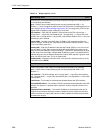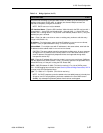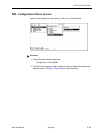
3. DSL Card Configuration
3-26
April 2001 8000-A2-GB26-50
VNID Binding Table A-E-C
Gives the user with Administrator permission the ability to configure one VNID association
on an individual port/interface.
Item
– Enter the Item number identifying the row listing the desired VNID (1–10)
(Default = 1). Does not appear if Action is set to Edit (see below). If VNID tagging has not
been set (see
General (General Bridge Parameters) A-E-A
on page 3-24), then only the
default VNID will display to allow configuration of its NHR.
DSL Interface
– Enter the DSL interface. Valid choices for the DSL card are dsl1:1
through dsl4:1 = 4-port DSL card interface; dsl1:1 through dsl12:1 = 12-port DSL card
interface, dsl1:1 through dsl24:1 = 24-port DSL card interface (Default = dsl1:1). Only one
interface per port is allowed.
Active VNIDs
– Number of the VNID. Enter 2–4000 for DSL cards with an Ethernet
network interface, 2–255 for DSL cards with an ATM network interface (Default = none).
For a list of VNIDs, press Ctrl-v.
Default NHR
– Enter the IP address of the Next Hop Router (NHR) in
nnn.nnn.nnn.nnn
format (Default = none). Enter a space to delete the current NHR entry (make sure all
users on the same VNID/port have an NHR entry). If the NHR IP address does not exist
for that client in the client table, a default NHR IP address is used. If the default NHR IP
address does not exist, the Address Resolution Protocol (ARP) request is ignored. Valid
value is 0–255 for each octet. This is an optional field.
Domain Name
– Displays the domain name, if one has been entered (read-only) in the
Card VNID screen (
A-E-B
).
Client Allocation A-E-D
Allows configuration of the number of clients/subnets behind each DSL interface.
Item
–
Enter the Item number identifying the row listing the desired VNID (1–10)
(Default = 1).
DSL Interface
– The DSL interface, dsl1:1 through dsl4:1 = 4-port DSL card interface;
dsl1:1 through dsl12:1 = 12-port DSL card interface, dsl1:1 through dsl24:1 = 24-port DSL
card interface.).
Total Entries
–
The number of clients/subnets allowed behind each DSL interface.
Allowed DHCP Entries
–
The number of DHCP clients that can be attached to each DSL
interface. An asterisk (*) indicates that the maximum number of dynamic clients is not
specified.
Additional Entries Available
–
The number of additional clients/subnets that can be
assigned to the interface. Maximum number of additional entries equals the maximum
number of entries in the pool (256) less the number of additional entries that have been
allocated from the pool.
Table 3-4. Bridge Options (3 of 5)


















